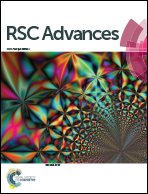Triple-shape memory effects of bismaleimide based thermosetting polymer networks prepared via heterogeneous crosslinking structures
Abstract
Functional physical behavior, including triple shape memory process and reversible actuation, has attracted great interest in the research field of thermosetting polymers in recent years. Herein, we synthesized a series of covalent crosslinking thermosetting polymers with triple shape memory effects via introducing bisphenol-A cyanate ester (BACE) to bismaleimide (BMI) networks. Due to the complex covalent crosslinking structures, such BMI based triple-shape memory polymers (TSMPs) present broad glass transition temperature ranges, which is a crucial precondition for the triple-shape memory behavior. Results demonstrated that BMI based TSMPs showed excellent thermal stabilities and mechanical properties. Moreover, triple shape memory behavior was achieved successfully by choosing two switching temperatures to fix two separate shapes independently. Upon heating, both the programmed shapes could recover to their former shape separately. This paper provides fundamental attempts for the further development of thermosetting triple shape memory polymers. Combining the superior comprehensive properties with the smart triple shape memory behavior, such materials present great potential to be applied as smart materials and structures, especially for aerospace areas.


 Please wait while we load your content...
Please wait while we load your content...